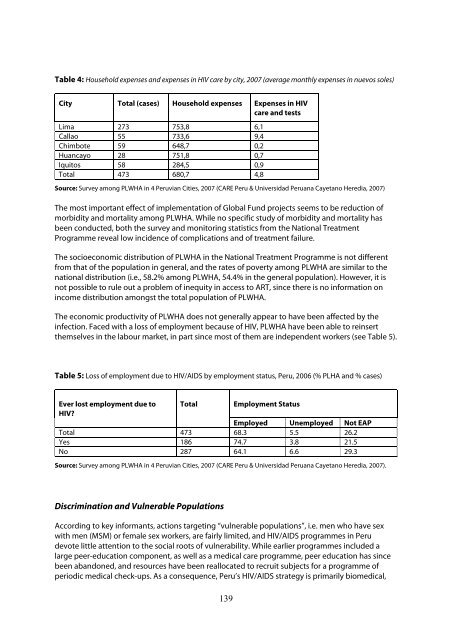MAXIMIZING POSITIVE SYNERGIES - World Health Organization
MAXIMIZING POSITIVE SYNERGIES - World Health Organization
MAXIMIZING POSITIVE SYNERGIES - World Health Organization
You also want an ePaper? Increase the reach of your titles
YUMPU automatically turns print PDFs into web optimized ePapers that Google loves.
Table 4: Household expenses and expenses in HIV care by city, 2007 (average monthly expenses in nuevos soles)<br />
City Total (cases) Household expenses Expenses in HIV<br />
care and tests<br />
Lima 273 753,8 6,1<br />
Callao 55 733,6 9,4<br />
Chimbote 59 648,7 0,2<br />
Huancayo 28 751,8 0,7<br />
Iquitos 58 284,5 0,9<br />
Total 473 680,7 4,8<br />
Source: Survey among PLWHA in 4 Peruvian Cities, 2007 (CARE Peru & Universidad Peruana Cayetano Heredia, 2007)<br />
The most important effect of implementation of Global Fund projects seems to be reduction of<br />
morbidity and mortality among PLWHA. While no specific study of morbidity and mortality has<br />
been conducted, both the survey and monitoring statistics from the National Treatment<br />
Programme reveal low incidence of complications and of treatment failure.<br />
The socioeconomic distribution of PLWHA in the National Treatment Programme is not different<br />
from that of the population in general, and the rates of poverty among PLWHA are similar to the<br />
national distribution (i.e., 58.2% among PLWHA, 54.4% in the general population). However, it is<br />
not possible to rule out a problem of inequity in access to ART, since there is no information on<br />
income distribution amongst the total population of PLWHA.<br />
The economic productivity of PLWHA does not generally appear to have been affected by the<br />
infection. Faced with a loss of employment because of HIV, PLWHA have been able to reinsert<br />
themselves in the labour market, in part since most of them are independent workers (see Table 5).<br />
Table 5: Loss of employment due to HIV/AIDS by employment status, Peru, 2006 (% PLHA and % cases)<br />
Ever lost employment due to<br />
HIV?<br />
Total<br />
Employment Status<br />
Employed Unemployed Not EAP<br />
Total 473 68.3 5.5 26.2<br />
Yes 186 74.7 3.8 21.5<br />
No 287 64.1 6.6 29.3<br />
Source: Survey among PLWHA in 4 Peruvian Cities, 2007 (CARE Peru & Universidad Peruana Cayetano Heredia, 2007).<br />
Discrimination and Vulnerable Populations<br />
According to key informants, actions targeting “vulnerable populations”, i.e. men who have sex<br />
with men (MSM) or female sex workers, are fairly limited, and HIV/AIDS programmes in Peru<br />
devote little attention to the social roots of vulnerability. While earlier programmes included a<br />
large peer-education component, as well as a medical care programme, peer education has since<br />
been abandoned, and resources have been reallocated to recruit subjects for a programme of<br />
periodic medical check-ups. As a consequence, Peru’s HIV/AIDS strategy is primarily biomedical,<br />
139

















